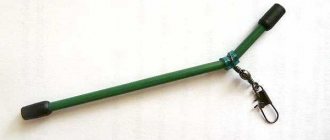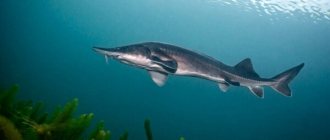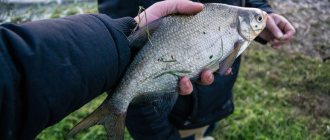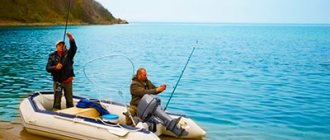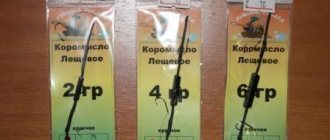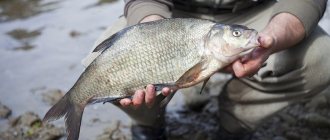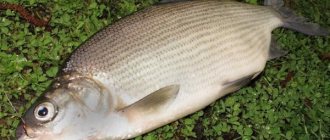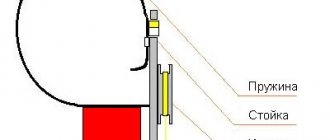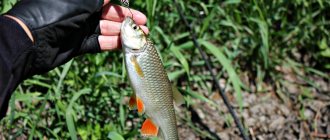A rubber or donka tackle with a rubber shock absorber is a kind of improved bait that can be used to catch not only bream, crucian carp, roach and other peaceful fish, but also predators.
For example, on the Volga and the rivers flowing into it, perch, sabrefish, and anadromous herring are successfully caught using elastic bands. Chub, asp, bershi and pike perch are common in the catch. At night, a catfish may be on the hook.
- Main line and leaders
- From shore and by boat
The principle of operation of the elastic band
The meaning of the design is that the tackle needs to be mounted once before fishing, thrown into the pond and not re-thrown again during the entire fishing. The result is a semi-permanent installation in which hooks with bait are delivered into the water by a rubber band.
After the fish is hooked, you pull up the main line, remove the catch, attach a new worm (cereal, “mastyrka”) and release the line. The shock absorber contracts, pulling the leashes into the depths of the river (lake, sea).
You can change the position of the hooks, lower them to the bottom or raise them higher, with a simple action, releasing or pulling the working line. And “revive” the baits, provoking the fish to bite by moving the thread. This is how fishing with a rubber band from the shore works. But with some dexterity, fishing is also possible from a boat.
Catching sabrefish with an elastic band
The method is attractive because each hook can be equipped for a different peaceful or predatory fish: sabrefish, pike, carp, herring (cases with the latter have been recorded by fishermen more than once).
How to tie an elastic band with fishing line
The overall performance of the equipment depends on the reliability of the connection between the base and the shock absorber. Sometimes, when the bite is good, the donk often has to be taken out of the water to land fish and change bait. When performing these operations, the main load falls on the junction of the cord with the shock absorber. Particular attention is paid to the careful connection of these elements in the overall design of the catching tool during the manufacture of elastic bands. In particular, from fishing practice, fishermen have chosen a number of effective and reliable methods for connecting these parts.
The most common way is to connect elements loop to loop. For these purposes, blind loops are knitted at the ends of the dissimilar materials being connected. Instead of direct ties, you can include additional accessories in the connection in the form of a swivel tied to the main fishing line and a carabiner that is attached to the shock absorber and connect the parts in this way.
An original and very reliable method is to connect into a tube. We put a polyurethane tube or plastic cambric over the shock absorber material and knit a blind loop. Then the tip of the main fishing line is inserted into the tube and a blind loop is also formed. The result is a connection without pulling together dissimilar materials, which does not cut the elastic and does not deform the structure of the main cord.
Scheme and elements
In assembled working form, the gear schematically looks like this: at the bottom of the reservoir, at a considerable distance from the shore, lies a heavy load thrown there. It could be a piece of lead or iron, stone, brick, or a railroad spike. A shock-absorbing thick elastic band that stretches at least 5 times is tied to the load through a short piece of rope (cord, thick fishing line). The main line tied to it is wound on a reel and secured on the shore to a pole (slingshot, rod stand). Along the base, leashes with hooks and feeders are located at a distance of one and a half meters (or less) from each other.
In the classic version, the tackle consists of parts:
- Reel. This is an auxiliary fishing device for storing and transporting lines and hooks. Shapes: circle, square, slingshot. Horns or hooks are fitted at the edges so that the tackle is wound correctly and does not slip or get tangled. Store-bought products are made of plastic and wood; at home you can use any material: polystyrene foam, cardboard, plywood.
- Main line. Assume that both small fish, for which a thin thread is enough, and carnivorous individuals, capable of tearing off all the equipment, will be tempted by your bait. Find a balance: install a strong transparent line with a thickness ranging from 0.2 to 0.5 mm. The length of the core is several times longer than the elastic band: tens of meters. The working section of the fishing line where the leashes are attached is called the stake.
- Leash. Its thickness is two hundredths of a millimeter thinner than the base. When pike predominate in a pond, install metal leashes. If there are less than 5 leashes, fishing with an elastic band from the shore loses its meaning.
- Hooks. On an unfamiliar body of water it is difficult to decide on hook numbers. Immediately install classic universal ones of medium size. Having become familiar with the dominant species of underwater inhabitants, install hooks under the trophy: you may need double and triple products of large numbers, like for a spinning rod.
- Sinker. Normal hunting depends on this element of equipment. Under all circumstances - fast current or standing water - the object must remain motionless at the bottom. On rivers with a turbulent watercourse, the “anchor” is often delivered by boat; the place is marked with a float-buoy tied with a thick fishing line to the load. You can pull out lead or stone on a pond by first winding the fishing line, then the shock absorber.
- Rubber. The central part of the equipment must be round. Faceted products are not suitable, as sharp corners rub against underwater obstacles and the elastic band cracks. If the element breaks, you will lose the sinker and your fishing will be ruined. Good rubber elongation – 1/5. But it’s better if it increases 3-4 times. Typically, elastic fishing with casting from the shore requires a shock absorber length of 5 to 20 m.
Connect the leashes to the base with swivels and carabiners, which facilitate installation and save the tackle from twisting. Don't forget the bell - an audible bite alarm. Feeder or “aviation” rubber with a diameter of at least 4 mm is suitable for insertion.
Your question to an expert
Leonid Grachev
Fisherman with a lot of knowledge and experience
Ask a Question
How to make a rubber band for fishing
In practice, assembling an elastic band for fishing is not difficult, and this does not require any special material costs. Most of the components of fishing gear are purchased at a fishing store, and some elements can be found at a construction or manufactured goods outlet, or simply picked up from available material. Lines and hooks are purchased from fishing nets.
The model and plywood blank for the reel are purchased from manufactured goods, and the load, based on the mass needed for fishing, is selected from any object suitable for this role, be it a metal blank or even a brick. The reel is cut out with a hacksaw from plywood, 20 mm thick, making 30x10 cm slots along the ends of the rectangle, required for the volume of fishing line depth in the form of a dovetail. To avoid the formation of burrs, the reel board is ground with fine sandpaper. A cord is attached to the reel, which can be taken in the form of monofilament or braided fishing line. Monofilament is used in a thickness of 0.25 to 0.70 mm. The braids are taken thinner, adapting diameters of 0.2-0.4 mm to the base. The length of the base varies from 20 to 100 meters, and more if necessary. Leashes are knitted from nylon with a length of 10 cm and above. The diameter of the leash material depends on the expected size of the trophy.
Important! Metal or fluorocarbon leashes are used for pike to prevent overbiting.
A round model is used as a shock absorber. A rubber band diameter of 0.7 to 1.2 mm is considered practical. The selection of thickness depends on the length of the base and the total mass of the bait being installed. For short-length donks and fishing with rigs in still water, purchased blind sinkers are used. For heavy and long equipment, it is more convenient to use brick or shaped paving slabs as a load. We will talk in more detail about some of the nuances of selecting and connecting equipment elements in the continuation of the article.
Sinker weight for elastic from shore
In quiet bodies of water, the “anchor” is usually cast by hand, sometimes catapulted with a sling. A throwing weight of 200-400 g is enough: more weight will not fly far.
On a watercourse, fishing with an elastic band from the shore is possible with a massive sinker of 1 kg or more. Deliver this weight by boat. At the end of fishing you will have to lift the object from the bottom, so mark the sector with a plastic bottle or stick tied to the anchor with a cord. The length of the rope is equal to the depth at which the load lies.
The shape of the sinker does not matter, the main thing is that the object is flat: the larger the area of contact with the bottom, the more securely the load will lie on it. For better grip, solder pieces of wire into the body of the sinker.
Weight for throwing gum
The load for precise casting of fishing elastic equipment must have a certain shape that experiences the least drag from the air during flight.
The load for a long flight after casting must have considerable, but not excessive weight, capable of carrying the attached fishing elastic equipment through the air, often experiencing considerable side gusts of wind.
Here I do not take into account the tension resistance of the rubber cord when the supporting line thrown from the reel is insufficiently long.
A load of any shape and weight should not move from the casting point (slide along the bottom) when pulling the fishing elastic rig to the shore up to the farthest hook.
These requirements directly depend not only on the shape and weight of the lead casting, which should be correctly tied to the rubber band equipment, but on the characteristics of the bottom of the reservoir chosen for fishing.
A cargo (compact shape) that splashes down with a minimal splash after casting should not scare away the fish at the upcoming fishing spot.
And, finally, the shape of the load after an inaccurate cast should allow a heavy blank with minimal hooks on the bottom to be pulled to the shore using a safety line.
These are the simple basic and far from excessive requirements for throwing a load of fishing elastic equipment into the place chosen for fishing.
How to assemble it yourself
The assembly process is fun and creative. It's good to have an assistant. Some fishermen living near reservoirs set up gear for the entire season.
The production of a structure for rubber band fishing from the shore takes place in several stages:
- Prepare a nylon cord 1 m long. Attach a weight to one edge. Make a casting loop in the middle of the rope.
- At the other end, mount a swivel (you can tie one of the fishing knots) and attach the rubber insert.
- Using a swivel or knot, attach the working part of the line - a stake with tied locking knots to secure small carabiners for leashes between them.
- Install leash gear with hooks at a distance of 0.5-1.5 m.
The free end of the fishing line, which you took with a reserve, is wound on a reel attached to a peg or other stand driven into the bank. The donka is collected, and further fishing with rubber from the shore consists of choosing a catch and baiting with fresh bait.
When a rubber band comes to the rescue
Drawing by the author
The main advantage of a donkey with a rubber shock absorber compared to a spinning rod is that the angler does not have to cast every time after catching a fish or checking the condition of the baits. In addition, it allows you to use delicate baits that are weakly held on the hooks, which is sometimes of no small importance and largely determines the success of fishing, especially at night.
There were times when some fishing experts reached the incredible in their conclusions. They say that bottom tackle with a rubber shock absorber is far from sports or, simply, almost poaching. Let me object: if an angler catches, say, carp or crucian carp with 4-5 spinning rods and this is not considered poaching, then why should there be a taboo on the “elastic band”?
There are conditions when fishing when it is simply impossible to succeed without this equipment. But more on that later. First, let’s get acquainted with the structure and technique of fishing with a donk with a rubber shock absorber.
To make this gear you will need any fishing line with a diameter of 0.5 mm, fishing line for leashes with a cross section of 0.2-0.3 mm, high-quality hooks with a very sharp sting, a round aircraft model rubber band of the “Hungarian” type, a fairly heavy flat-shaped lead weight and a buoy. This special load must be equipped with an anchor made of copper or brass wire with a diameter of 1-2 mm. As a stand, it is best to use a steel rod with a pointed lower end; an inertial reel is attached to the upper end of the rod, on the drum of which 100 m of fishing line is wound. The reel must be equipped with a ratchet brake. A stake approximately 1.5 m long with leads is stored on a separate reel. The entire assembled tackle is shown in the figure.
Having several elastic bands of different lengths, such a bottom can be used to catch fish both close to the shore and at a considerable distance from it. The ratio of the length of the elastic band and the fishing line should be approximately 1:4 (meaning fresh “Hungarian”).
IF YOU DON'T HAVE A BOAT There are fishing situations when a short bottom with an elastic band, the hooks of which are located no more than, say, thirty meters from the shore, can bring stunning success. For many years I have been catching large bream in the lower reaches of the Dubna River (and here it usually catches at night) and have repeatedly been convinced that without a short bottom with a rubber shock absorber, my chances would be zero.
The main difference from a donkey with a rubber shock absorber, which is launched from a boat, is that you can throw a load of a certain weight to the desired distance from the shore. And to remove it later after fishing, you need a towing cord, which is attached to the sinker and moved away from the main fishing line. Thus, you throw the donk and the towing line at the same time, taking into account the permissible stretch coefficient of the elastic band. For final installation of the gear, all that remains is to attach the bite alarm and leashes with hooks.
After finishing fishing, remove the leashes and, using a towing line (usually its diameter is 0.8-1 mm), pull the sinker and bottom to the shore.
LONG BOTTOM But when it comes to large bodies of water (lakes, reservoirs), usually experienced bottom fishers, working together, act as follows. One of them brings the equipment to the required distance on a boat, and the other at this time releases the rubber band attached to the fishing line until it becomes clear from the tension that it is undesirable to stretch the rubber further. After a command from the shore, the first angler lowers the weight to which the elastic is attached to the bottom, having previously freed the fishing line from the split of the buoy. The line from the buoy is easily unwound until the load falls to the bottom. After this, the excess fishing line should be wound around the buoy and brought back into the split. The line on the buoy must be strong so that after fishing you can lift the load without any problems.
In practice, the calculation comes down to the following. Let’s assume that the distance from the bank to the pre-channel edge, where hooks with nozzles need to be delivered, is 60 m. To do this, you will need a piece of elastic 20 m long (taking into account an acceptable stretch coefficient). We add 20 m to sixty meters, therefore, we must lower the load at a distance of 80 m from the shore. In this case, the elastic band will stretch approximately four times.
Having delivered the load and the buoy to the right place, a stake with leashes is attached to the end of the elastic band, tied with a loop, using a swivel fastener, which in turn is connected to the main fishing line. In some cases, it may be advisable to install a miniature wire feeder near the rubber band. If you periodically feed from a boat, before lowering the bait balls, you need to select the equipment and, taking into account the depth at the fishing site, tie a small foam buoy to the stake, which will indicate the feeding point.
When fishing with a rubber band, you need to be extremely careful about your own safety so as not to get hurt by the hooks. Therefore, in order to avoid troubles, a reliable loop is made at the end of the main line, with the help of which the equipment is secured to the main or auxiliary stand both when changing attachments and when landing fish, which are best caught with a landing net.
Bite alarms in such gear can be traditional bells, metal plumbs; during daylight hours, the bite is clearly visible on the fishing line, and with a strong pull, the ratchet brake is activated.
HOW TO FEED? Any feed mixture must be fresh. The following components are usually used by bottom fishermen: ground wheat crackers, steamed cereal grains, ground roasted sunflower seeds, hemp and flax seeds, boiled crushed potatoes (new), granulated feed based on cakes, ground sunflower cake, oatmeal, chopped worms , maggots, food bloodworms. And, of course, branded factory mixtures, the secret of the composition of which is not disclosed due to mercantile interests.
All components selected for specific fishing conditions are first mixed dry in a bucket, then water from the reservoir is added, the amount of which determines the viscosity of the bait composition. Balls of bait cast from the shore, lowered from a boat to the fishing point, and bait for filling a feeder or delivering it using hooks are not exactly the same thing. The viscosity must be appropriate.
THE MAIN OBJECT IS BREAM AND MORE And now here’s what. It would not be entirely correct to consider fishing with a donk with a rubber shock absorber regardless of this or that fish. And above all, to catch bream.
Once, my friend and I arrived at the Ruza Reservoir at the end of July. Heat! The thermometer froze at 32 degrees. It would seem that the chances of successful fishing, especially of catching at least 2-3 respectable bream, are zero. In reality, everything turned out differently.
After we pumped up the boat and stuck the risers of two donks into the clayey bank, Alexey said: “Feed off the line from the reel of one, then the other donk, until I bring them to the desired feeding point.” Here I have my guidelines. And we must clearly get to the edge where the bream is now feeding. Alexey climbed into the boat and slowly swam to the middle of the reservoir.
We got to the edge. And the sleepless night gave us some good bream. And we caught it on a crust of white bread soaked in unrefined sunflower oil. I catch large crucian carp at night in the same way.
In general, it must be said that a donka with a rubber shock absorber is intended primarily for catching non-predatory fish, but with some modernization it can also be used for catching predators near the surface and in the water column. In the first case, you need to put longer leashes (so that the baitfish can walk more freely), usually 50-60 cm, and use larger and stronger hooks. And so that the live bait does not “hide”, the leashes must be raised above the bottom vegetation. This is done using foam buoys, which are tied close to the stake or between leashes with hooks scattered along the main line. Buoys lift the equipment to the surface of the water. This kind of “elastic band” is especially effective when fishing for pike perch and pike in coastal areas at night.
In the second case, in order to place live bait or other baits above the bottom, elongated standing sinkers like the “Vanka-Vstanka” are used in combination with foam floats that are attached to the main fishing line.
Be that as it may, fishing with a donk with a rubber shock absorber is exciting in its own way and often very rewarding.
Vladimir Tarkhanov July 30, 2012 at 00:00
Baits and lures
The “rubber band” tackle is aimed at “peaceful” and predatory species: catfish, pike, roach, bleak, gudgeon, carp, perch. Choose bait in accordance with the preferences of the future prey.
Fishing with a rubber band
For underwater inhabitants that feed on vegetation, stock up on boiled peas, pearl barley, and canned corn. Prepare flavored dough and bread. Animal baits that work well include worms, maggots, and bloodworms.
Tempt carnivores with live bait: frogs, fish fry.
Where to fish with an elastic band?
Large rivers and reservoirs will be ideal fishing spots The elastic can be thrown along the coastal vegetation or, conversely, into the middle of the reservoir, where there is expected to be a significant difference in depth or deep holes.
In any case, you should focus on natural shelters for pike. It is an ambush predator that prefers to stand still while waiting for prey. Therefore, various snags, fallen trees, steep banks with holes or reed thickets can be considered a good place to throw gear next to them. Small bodies of water are not suitable for elastic fishing.
Catching
Prepare the “Garland” at home. On the shore of the reservoir, carefully unwind it from the reel, laying it in rings on the mat: the tackle will get tangled in the grass and shell beach. Prepare leashes with hooks in advance.
Drive the stand into the ground and deliver the cargo (manually or by boat) to the destination sector. When the “anchor” settles thoroughly to the bottom (5-6 minutes), choose a bet, attach the leashes with attached bait alternately, and fill the feed containers.
Near the peg holding the reel, install a bell guard on the fishing line, designed to notify you of fish attempts to take the bait. Some fishermen use a simple twig as a bite alarm. Instead of a reel, it is convenient to fix an old spinning rod with a reel on the shore.
The line with a slight slack goes to the reel. Wait for the bite, animate the bait. In this version of the donkey, the fish hooks itself; there is no need to reel in the catch. If you notice a bite, pull out the line, remove the prey, and attach a new bait. Release the line: the contracting shock absorber will deliver the hooks where they need to be.
Fishing with a rubber band from the shore is not difficult for novice fishermen, and experienced fishermen consider the old-fashioned method more effective (albeit less mobile) than modern gear. This method is used on the Amur, Volga, and Kuban rivers.
Basic elements of elastic
The elastic tackle is based on a reel, which, due to its volume, allows you to store the required length of the shock absorber and the main cord. The frame of the tackle is the main cord, which can be made of monofilament or braided fishing line. The next element of the equipment is the shock-absorbing elastic band itself, which is attached to the end of the main cord, and at the end of the shock absorber itself, a sinker is attached to it. The most useful equipment for fishing is leashes with hooks. They are connected to the main line through a certain distance required by fishing conditions.
Sometimes, for specific hunting conditions that require holding baits at certain levels of the water column, anglers use foam weights of various weights, which are additionally mounted on a leash. The donkey also includes a signaling device that can notify the fisherman in some effective way that a bite has occurred.
What time of year and day
Experienced hunters do not fish at random. Depending on the time of year, rubber band fishing from the shore brings different catches:
- In the spring, fishermen go for sabrefish, bleak, and roach. White bream and blue bream also end up in the spring cage.
- In summer you can catch bream, pike perch, perch, crucian carp, and catfish. Bleak, bluegill, roach and silver bream actively go for bait even on summer days.
- In the fall, pike, pike perch, and bream are more likely to bite. The same bluegill and roach fatten up before wintering and grab the stored goodies from the hook.
The quality of the tackle and bait influence the bite. But there are other factors: weather, atmospheric pressure, even moon phases.
Usually the fish are hungry in the hours before dawn (this is called the morning glutton). The crucian carp stops biting 15 minutes before sunrise, the carp feeds for another hour. As soon as the sun warms up the shallows, the fish rush into warm water. At midday, the inhabitants of reservoirs are passive and go deeper. In the evening, the bite becomes active: pike perch, ide, and tench readily take bait from about 19 to 21 hours.
Complex tackle with a rubber insert is installed for a long time, so you go home with your catch.
Sinker used
The sinker is one of the main elements of tackle with a rubber shock absorber and its task is to firmly hold the rubber. When reeling out the gear, the shock absorber is in a tense position and the load is under serious stress. Many anglers prefer to make their own cast lead weights with a ring for tying the cord.
To increase the grip of the sinker during its manufacture, metal pins (from nails) are fused into the lead, firmly holding the equipment even on a muddy bottom. It is advisable to carry a spare load with you, because anything can happen when fishing, and if there is a break, you will have to stop fishing, unless, of course, you don’t have a spare.
Weather influence
Some anglers keep weather diaries, trying to forecast the next hunt. But this is a futile endeavor.
However, the weather still affects the bite:
- fish take bait better after a storm;
- abnormal atmospheric pressure reduces the activity of aquatic life;
- colder temperatures in summer lead to a decrease in biting, and in autumn - to an increase in the appetite of fish.
If you don’t bite today, don’t blame the weather – perhaps there are no fish in the pond.
Bite alarm
When fishing with a rubber band, it is best to use a regular bell attached to a rubber cone as a signaling device. A slot is made in the cone for the fishing line, and installing the signaling device takes very little time. Due to the fact that the bell is suspended, it signals a bite in the depths and a bite in the shore.
This is important, because each fish bites differently and the fisherman must be ready to quickly hook. Electronic alarms are inconvenient because they require constant adjustment, literally after every tightening of the tackle. Using a bell is also beneficial from a financial point of view, and even if it gets lost in the grass, replacing it will not require significant financial costs.
The use of a rubber band allows you to catch both small and large fish, both from the bottom and from the surface. Its production takes very little time and does not require large expenses for components. So every amateur fisherman who wants to increase his catches would be nice to have such gear.
Features of catching different fish
Fish habits and lifestyle features place different demands on bottom equipment.
Tackle elastic band with net
Equipping gear with shock-absorbing rubber also has its own nuances.
Zander
The twilight predator leaves the pits in the evening and morning hours and moves along the dumps.
List of equipment for pike perch:
- fishing line – 0.4-0.5 mm;
- leashes – 0.24-0.3 mm, length – 10-15 cm;
- hooks – No. 7-8;
- rubber – stretch coefficient 4;
- sinkers - weight 200-400 g in still water, up to 1 kg in fast currents;
- bait - live bait.
Fishing feature: wind the supply of fishing line not on the reel, but on a coastal bush. The bush will provide additional shock absorption, which will quickly exhaust the strength of the pike perch, and the predator will soon give up.
Pike
Place the tripwire near hydraulic structures, in places with changes in depth, not far from snags.
Equipment elements:
- fishing line – 0.3-0.5 mm;
- leashes – metal, interval 70-100 cm;
- hooks - doubles, tees;
- cargo - according to the conditions of the reservoir;
- bait - live bait, characteristic of the area.
The pike hooks itself onto the tackle; there is no need to land the fish. Stock up on a landing net with a long handle to make it easier to pull out tired fish.
Chekhon
The heat-loving fish feeds on phytoplankton, worms, larvae, and fry. The saber fish becomes a predator from the age of three. The fish lives in rocky holes, on riffles of water, in places where currents converge.
Equipment for elastic band:
- fishing line – 0.3-0.5 mm;
- leashes – 0.25 mm;
- hooks – No. 6, 7, 8;
- load – up to 1 kg.
Keep the hooks in the middle water horizons, making sure that the worm does not hang from the sting, otherwise the fish will take the bait and leave.
Carp
Strong, cautious fish need to be thoroughly fed with mixtures with sunflower cake. Carp are found at a depth of 1.5-2.0 m, 40-50 m from the shore, so it is better to transport the cargo by boat. Do not place more than 5 leashes, keep a distance of more than a meter between them.
Equipment items:
- fishing line – 0.25-0.35 mm;
- leashes – 0.2 mm, length – up to 50 cm;
- weight – studded, 200 g;
- hooks – No. 4, 5.
You should be prepared for a long struggle and desperate resistance. Choose thick rubber with the ability to stretch 5 times. You need to pull out the catch with a landing net.
Som
Tempt a gourmet with a grasshopper, pieces of animal meat and liver, fish fragments, mole crickets, and frogs.
Equipment characteristics:
- fishing line – up to 1 mm;
- leashes – 0.8 mm;
- load – over 1 kg;
- hooks - tees.
You can find the giant in whirlpools, near dams, dams, and on a clear night in the shallows.
Bream
A cautious bream will not approach the rubber band if it smells technical fluids. Therefore, keep your equipment clean.
Donkey equipment:
- fishing line – 0.25-0.30 mm;
- leashes – 0.25 mm, length – 20-25 cm;
- sinker – 200-300 g, or up to 1 kg;
- hooks – No. 4-6.
Do not offer store-bought bait to bream; it is better to steam the peas.
crucian carp
The ubiquitous crucian carp love bloodworms, maggots, and hominy flavored with fragrant vegetable oil. Fill the feeder spring feeders with it and distribute the containers evenly over the working base.
Characteristics of equipment elements:
- fishing line – 0.30-0.35 mm;
- leashes - two hundredths thinner than the base;
- sinker – lead weighing 200-400 g;
- hooks – No. 4, 5, 6.
Connect fishing line, rubber, nylon cord with winding rings.
Perch
June is the time of active hunting for spawning perch.
Gear device:
- fishing line – 0.8 mm;
- leashes – 0.2 mm, length – 25-30 cm, distance – 80 cm;
- load – 200-300 g;
- hooks – No. 6, 7;
- bait - fry, worms.
Provoke the fish to bite by frequently pulling the line toward you.
Carp
A restless carp with a quick reaction, it is capable of jerking with a force of 50 kg. Therefore, you need to make strong tackle.
Equipment items:
- fishing line - 0.3 mm and above;
- leashes – 0.25 mm, length – 50-70 cm, distance between leashes – up to 1 m;
- load – depends on the body of water;
- hooks - with a short shank, sting - with notches;
- bait - peas, corn, cereals, berries.
Carp are easy to catch in warm water with a weak current. Feed the fish in advance, before installing the gear.
Fishing on the current
A significant drawback of the design of the tackle when fishing in the current is the insufficient weight of the sinker. If the load does not hold the tackle in one place, then the force of the current will carry it down, and normal fishing with such tackle will not work.
A sinker of a suitable shape and weight can be made independently or purchased at a fishing store. If it was not possible to obtain a load of the required mass, then you can tie together several lead weights of lesser weight. Or melt down the lead and pour it into a rectangular, flat mold.
For this purpose, you can successfully use a flower pot with soil or sand. The shape of the future sinker is squeezed out in the ground, and molten lead is poured into this shape. After the metal has cooled, using a drill and a small-diameter twist drill, a through hole is drilled. It is necessary to chamfer the resulting hole with a drill of a larger diameter, otherwise the fishing line will be damaged by the protruding sharp edges.
With a massive load, you should not be afraid of the gear being carried away by the current, but hooks with bait will always be in the water column while fishing, which will negatively affect the fishing of bottom species.
To ensure that the bait is always at the bottom of the reservoir, you should additionally load the leash line. For this, sheet lead is used, which is used to surround the leash line at a distance of 10 - 15 cm from the hook. To prevent the sinker from moving along the leash, it must be slightly squeezed using pliers.
When fishing with an elastic band in a strong current, the tackle is subjected to significant lateral loads, so for such conditions a shock absorber with a thickness of at least 6 mm is used.
The process of casting tackle is carried out in the following sequence:
- The tackle is completely unwound on the shore of the reservoir , so that when casting there are no obstacles in the way of the fishing line.
- The reel is attached to a stationary peg driven into the ground, or held in a free hand.
- Bait is strung on the hooks , and if a tackle with a feeder is used, then it must also be filled with bait.
- The fisherman stands on the side of the unwound fishing line laid out on the shore and casts the sinker a little higher upstream.
- After casting, a pause of 5–10 seconds is maintained , which is necessary to lower the sinker to the bottom of the reservoir.
- Excess fishing line is taken out of the water and wound on the reel.
- A bite alarm is installed on the tackle.
If the weight of the sinker was selected correctly, then even when fishing in a strong current, the tackle will not be carried downstream, and when biting a large fish, as well as during fishing, the load will be in the place where it was thrown at the very beginning of fishing.
Fishing with an elastic band from the shore - tips for beginners
Russian fishermen - the inventors of an unusual type of bottom fishing - have accumulated considerable experience in it.
Tackle elastic band
Tips for beginners:
- Do not tie the elastic directly to the sinker - it will quickly wear off.
- If you throw a load with your right hand, stand to the left of the tackle. Do the opposite if you are left-handed.
- In fast currents, deliver the load several meters higher along the river bed.
- It is convenient to use a railway “crutch” as a sinker. To stop it, pull the tackle towards you.
- Wear gloves with cut phalanges: this way you will not get burns on your hands from friction with the fishing line.
- Securely secure the slingshots to the shore and the loops on them, otherwise you may get injured by the hooks.
- Do not keep the rubber too tight: the tackle should have some slack.
- When collecting equipment after fishing, wind the line loosely on the reel. As the thread dries, it shrinks.
Hunters who have had run-ins with the law are not advised to attach more than 10 leashes to shock-absorbing tackle. Each region has its own requirements, but in most regions, catching fish with more than a dozen hooks is considered poaching.
Installation highlights and some nuances
For more profitable use of the gear, ordinary feeder feeders are additionally added to it.
These feeders are placed at a distance between the leashes. Springs can also be used when fully equipped. This technique works flawlessly on crucian carp.
Another important nuance is the weight of the sinker; the heavier it is, the better.
Remember that a load in water loses 1/3 of its weight. It will be very inconvenient to fish when, when the elastic band is pulled, the sinker moves out of place, and it must be corrected every time.
What about cast length? Let's do the math - a standard rubber band has a length of 10-20 meters, with an increase of 5 times we get a distance of 50-100 meters. It is to this distance that the sinker will need to be delivered.
How to calculate the length of an elastic band for a tackle?
The simplest rubber band stretches to its maximum 7 times, but this maximum stretch is on the verge of breaking. Therefore, an increase of 6 times may be the limiting value. The length of the elastic is very simply determined by the formula: L (length of the elastic) = L (catching distance): 5
Why is it necessary to divide by 5? The error in this case is the length of the elastic band itself, well, this is so with a margin. As a result we get; if you plan to fish in a small body of water 25 meters from the shore, then the length of the elastic band will be 5 meters, respectively. At 50 meters it is 10 meters of rubber, at 75 meters it is 15 meters and so on, ascending.



